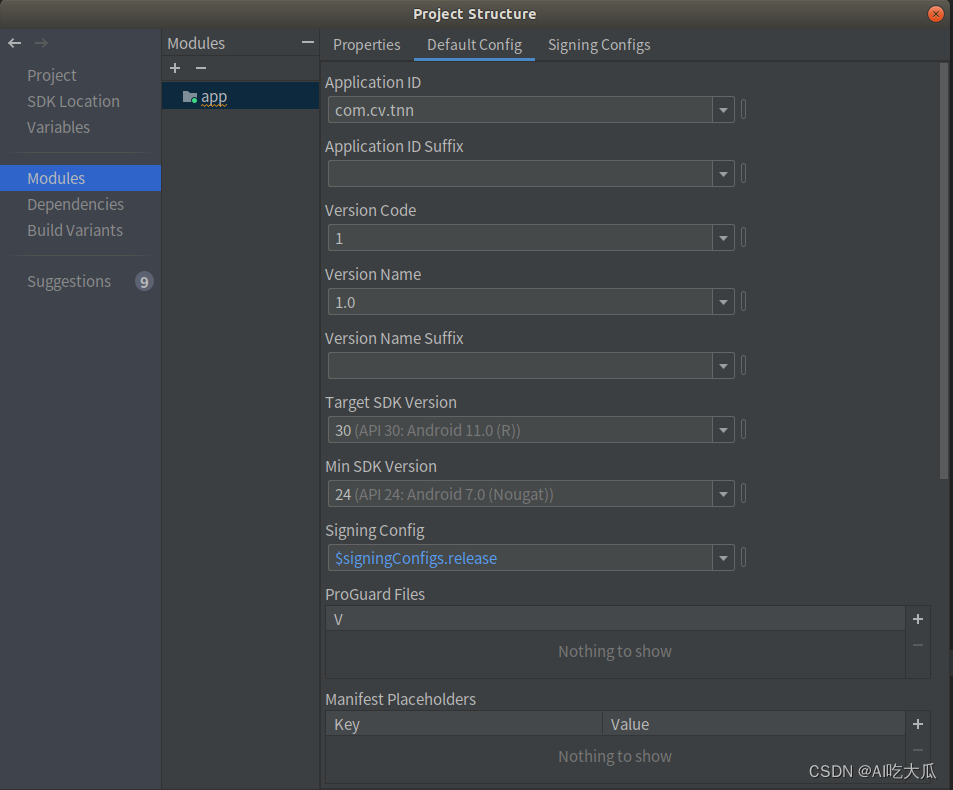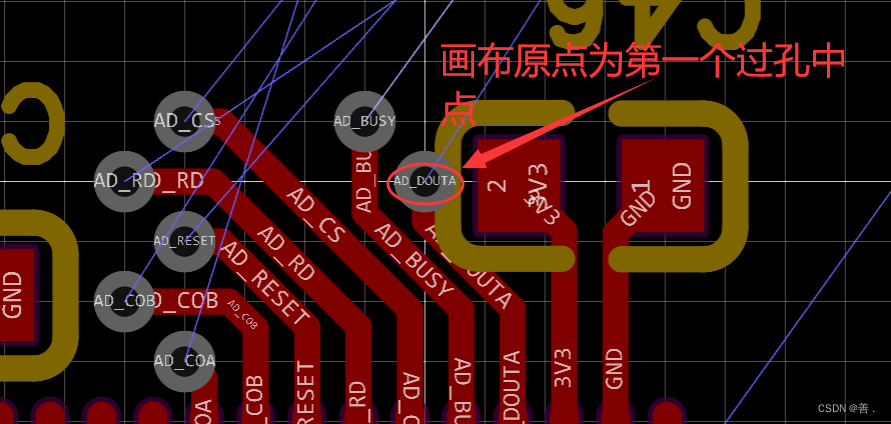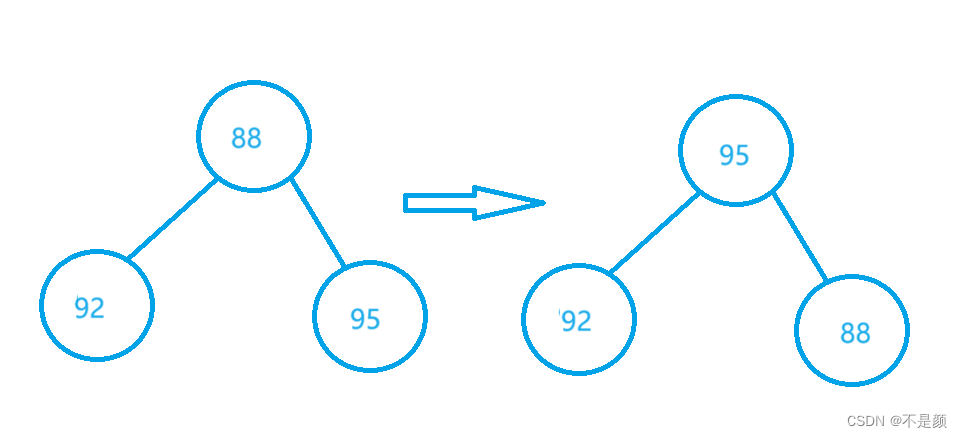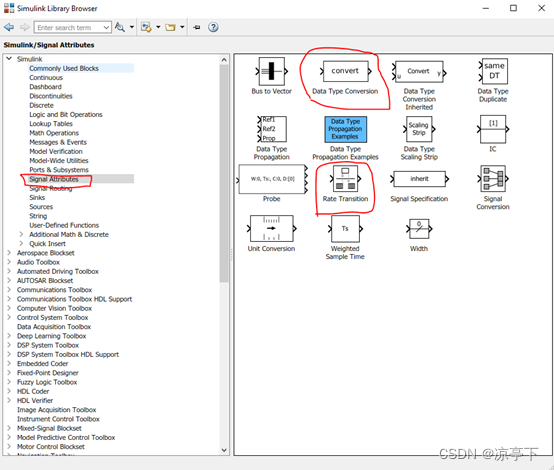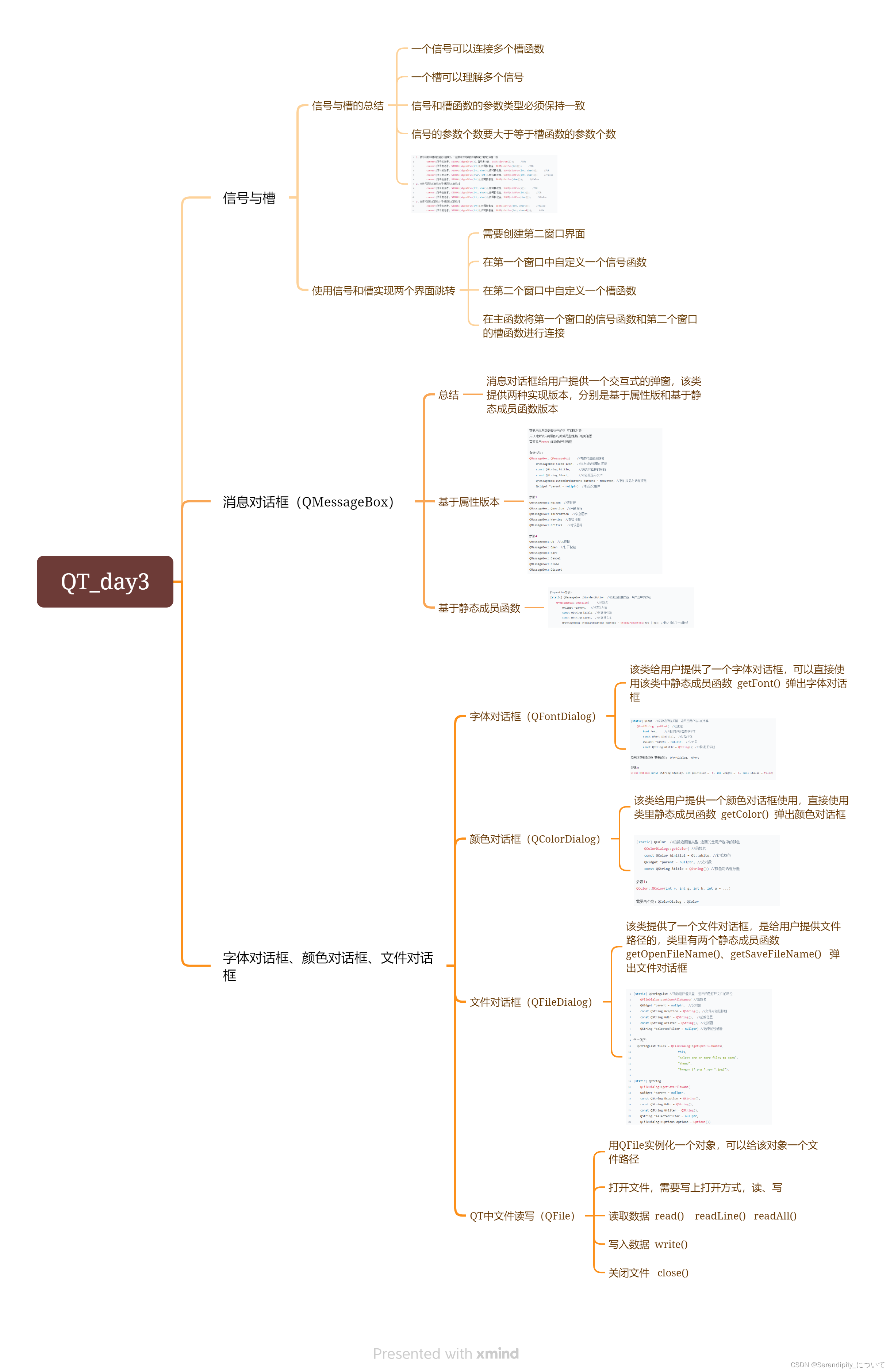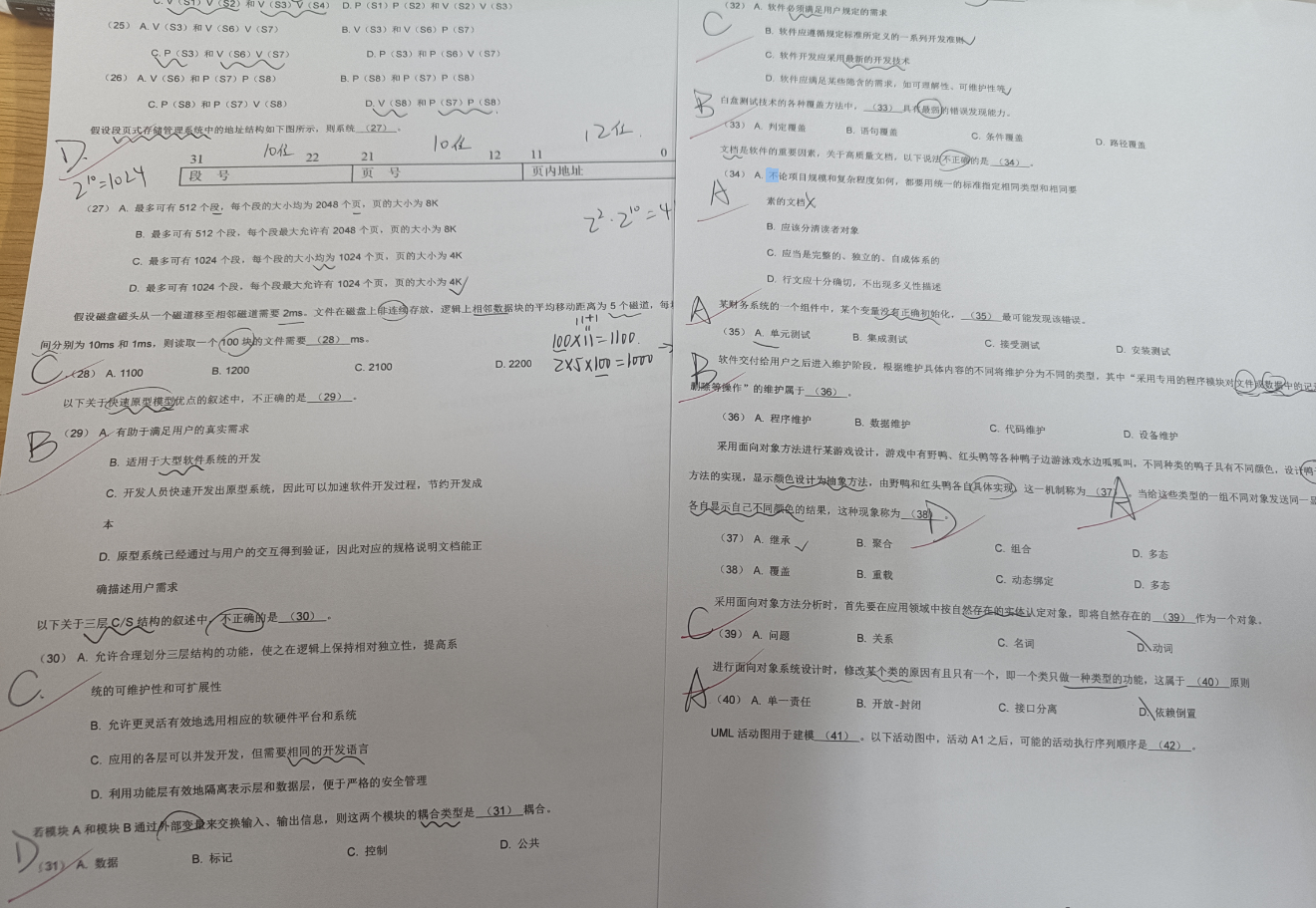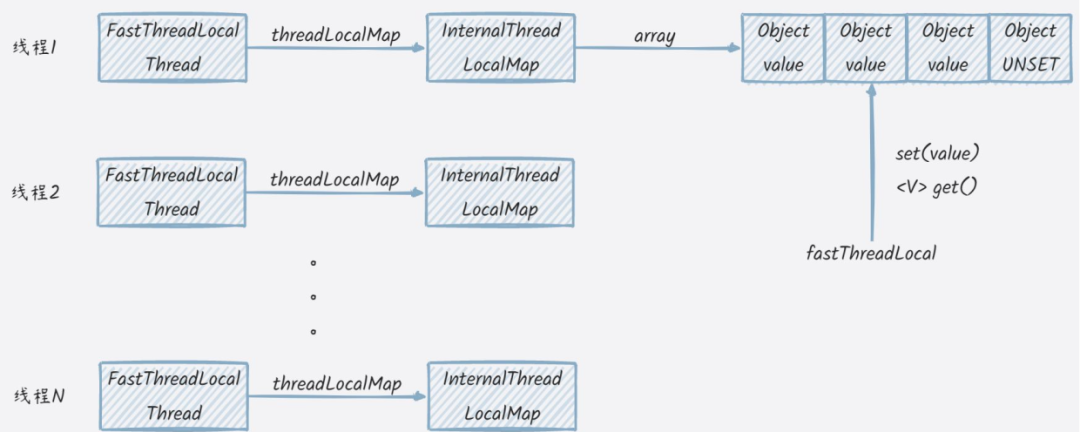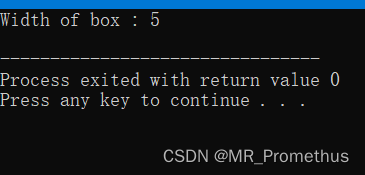一百一十三、消息对话框 (QMessageBox)
- 消息对话框给用户提供一个交互式的弹窗,
- 该类提供两种实现版本,
- 基于属性版本
- 基于静态成员函数版本
- 基于属性版本
- 需要用消息对话框这样的类 实例化对象
用该对象调用类里的相关成员函数进行相关设置
需要调用exec()函数执行对话框有参构造: QMessageBox::QMessageBox( //有参构造的函数名 QMessageBox::Icon icon, //消息对话框里的图标 const QString &title, //消息对话框的标题 const QString &text, //对话框显示文本 QMessageBox::StandardButtons buttons = NoButton, //提供消息对话框按钮 QWidget *parent = nullptr) //指定父组件 参数1: QMessageBox::NoIcon //无图标 QMessageBox::Question //问题图标 QMessageBox::Information //信息图标 QMessageBox::Warning //警告图标 QMessageBox::Critical //错误图标 参数4: QMessageBox::Ok //OK按钮 QMessageBox::Open //打开按钮 QMessageBox::Save QMessageBox::Cancel QMessageBox::Close QMessageBox::Discard 举个例子: QMessageBox msgBox; msgBox.setText("The document has been modified."); msgBox.setInformativeText("Do you want to save your changes?"); msgBox.setStandardButtons(QMessageBox::Save | QMessageBox::Discard | QMessageBox::Cancel); msgBox.setDefaultButton(QMessageBox::Save); int ret = msgBox.exec(); - ui界面:
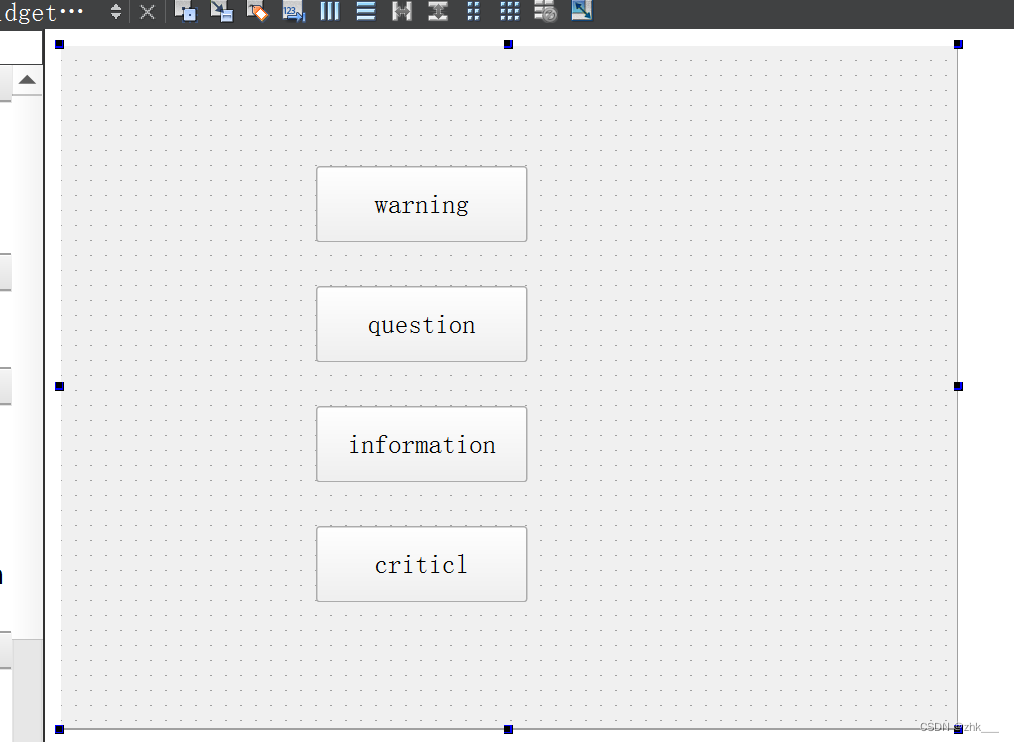
- 示例 :
//警告按钮对应的槽函数处理 void Widget::on_pushButton_clicked() { //用消息对话框这样的类 实例化一个对象 QMessageBox msg( QMessageBox::Warning, //图标 "警告", //对话框标题 "你给我小心点", //对话框文本 QMessageBox::Yes | QMessageBox::No, //提供按钮 this); //父对象 //要用exec()函数执行对话框 int ret = msg.exec(); //对用户选中的按钮进行判断 if(ret == QMessageBox::Yes) { qDebug() <<"好哈哈哈"; } else { qDebug() <<"别这样。。"; } }
- 需要用消息对话框这样的类 实例化对象
- 基于静态成员函数消息对话框的弹出
- 不需要实例化对象了,直接调用该类里的静态成员函数,
- 提供了四个:critical、information、warning、questio
- 以question为例:
[static] QMessageBox::StandardButton //函数返回值类型,用户选中的按钮 QMessageBox::question( //函数名 QWidget *parent, //指定父对象 const QString &title, //对话框标题 const QString &text, //对话框文本 QMessageBox::StandardButtons buttons = StandardButtons(Yes | No)) //默认提供了一对按钮 - 示例 :
//问题按钮2对应的槽函数处理 void Widget::on_pushButton_5_clicked() { //直接调用静态成员函数 int ret = QMessageBox::question(this, "问题", "天亮了吗", QMessageBox::Yes | QMessageBox::No); //判断用户选的按钮 if(ret==QMessageBox::Yes) { qDebug() <<"亮了"; } else { qDebug()<<"还没"; } }
一百一十四、字体对话框、颜色对话框、文件对话框
114.1 字体对话框 (QFontDialog)
- 该类给用户提供了一个字体对话框,可以直接使用该类中静态成员函数 getFont() 弹出字体对话框。
- getFont() 函数 :如果想使用该函数 需要的头文件: QFontDialog、 QFont
[static] QFont //函数返回值类型 返回是用户选中的字体 QFontDialog::getFont( //函数名 bool *ok, //判断用户是否选中字体 const QFont &initial, //初始字体 QWidget *parent = nullptr, //父对象 const QString &title = QString()) //对话框的标题 参数2: QFont::QFont(const QString &family, int pointSize = -1, int weight = -1, bool italic = false)- ui界面
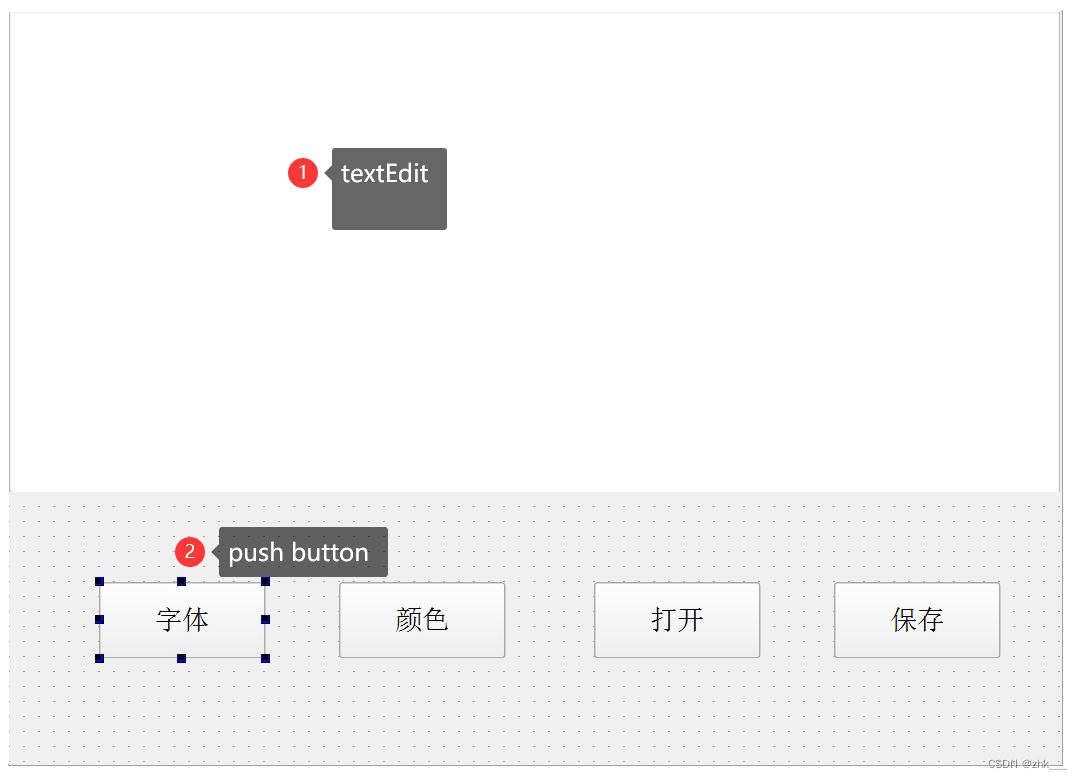
- 示例 :
//字体按钮对应的槽函数 void Widget::on_fontBtn_clicked() { bool ok; //判断用户是否选中了字体 //调用静态成员函数弹出对话框 QFont f = QFontDialog::getFont(&ok, //判断用户是否选中了字体 QFont("隶书",8,10,false),//初始字体 this, //父对象 "字体");//标题 //判断ok,如果用户没有选中字体,那么ok是false,否则是true if(ok) { //说明用户选中了字体 //将用户选中的字体设置文本中 //ui->textEdit->setFont(f); //让文本全部设置成该字体 ui->textEdit->setCurrentFont(f); } else { //说明用户没有选字体 QMessageBox::information(this,"提示","没有选字体"); } }
114.2 颜色对话框 (QColorDialog)
- 该类提供一个颜色对话框给用户使用,直接使用类里静态成员函数 getColor() 直接弹出颜色对话框
- getColor() : 需要两个头文件:QColorDialog 、QColor
[static] QColor //函数返回值类型 返回的是用户选中的颜色 QColorDialog::getColor( //函数名 const QColor &initial = Qt::white, //初始颜色 QWidget *parent = nullptr, //父对象 const QString &title = QString()) //颜色对话框标题 参数1: QColor::QColor(int r, int g, int b, int a = ...) - 示例 :
//颜色按钮对应的槽函数处理 void Widget::on_colorBtn_clicked() { //直接调用颜色对话框的静态成员函数 QColor c = QColorDialog::getColor(QColor(0,255,255), this, "颜色对话框"); if(c.isValid()) //判断是否是有效颜色 { //说明用户选中的是有效颜色 //将选中的颜色设置到文本中 //ui->textEdit->setTextColor(c); 设置前景色 ui->textEdit->setTextBackgroundColor(c);//背景色 } else { //说明用户选中的是无效颜色 QMessageBox::information(this,"提示信息","选中的是无效颜色"); } }
- getColor() : 需要两个头文件:QColorDialog 、QColor
114.3 文件对话框 (QFileDialog)
-
该类提供了一个文件对话框,用于给用户提供文件路径,
-
类里有两个静态成员函数 getOpenFileName()、getSaveFileName() 弹出文件对话框
- 都需要包含 QFileDialog、QFile 这俩头文件
- getOpenFileName()
[static] QStringList //函数返回值类型 返回的是打开文件的路径 QFileDialog::getOpenFileNames( //函数名 QWidget *parent = nullptr, //父对象 const QString &caption = QString(), //文件对话框标题 const QString &dir = QString(), //起始位置 const QString &filter = QString(), //过滤器 QString *selectedFilter = nullptr) //选中的过滤器 - 举个例子:
QStringList files = QFileDialog::getOpenFileNames( this, "Select one or more files to open", "/home", "Images (*.png *.xpm *.jpg)"); - getSaveFileName()
[static] QString QFileDialog::getSaveFileName( QWidget *parent = nullptr, const QString &caption = QString(), const QString &dir = QString(), const QString &filter = QString(), QString *selectedFilter = nullptr, QFileDialog::Options options = Options())
-
读文件
//打开按钮对应的槽函数实现 void Widget::on_openBtn_clicked() { QString fileName = QFileDialog::getOpenFileName(this, //父对象 "打开文件", //标题 "./", //起始位置 "All(*.*);; Img(*.png *.jpg *.gif);; 文本(*.txt)");//过滤器 qDebug() <<fileName; //实例化一个文件的对象 QFile file(fileName); if(!file.exists()) { return; } //打开文件 if(!file.open(QFile::ReadWrite)) //判断是否能成功打开 { return; } //读取文件内容 QByteArray msg = file.readAll(); //关闭文件 file.close(); //将读取的内容放入textEdit上 //ui->textEdit->setText(QString::fromLocal8Bit(msg)); ui->textEdit->setText(msg); } -
写文件
//保存按钮对应的槽函数 void Widget::on_saveBtn_clicked() { QString fileName = QFileDialog::getSaveFileName(this); //实例化一个文件类对象 QFile file(fileName); //打开文件 file.open(QFile::WriteOnly); //获取textEdit上的内容 QString msg = ui->textEdit->toPlainText(); //写入数据 file.write(msg.toLocal8Bit()); //关闭文件 file.close(); }
114.4 qt中文件读写
- 用到的类是 : QFile
- 步骤 :
- 用QFile实例化一个对象,可以给该对象一个文件路径
- 打开文件 需要写上打开方式 读、写
- 读取数据 read() readLine() readAll()
- 写入数据 write()
- 关闭文件 close()
小作业 完善登录框,并跳转到下一界面
1. 点击登录对话框,如果账号和密码匹配,则弹出信息对话框,给出提示”登录成功“,
提供一个Ok按钮,用户点击Ok后,关闭登录界面,跳转到新的界面中
2. 如果账号和密码不匹配,弹出错误对话框,给出信息”账号和密码不匹配,是否重新登录“,
并提供两个按钮Yes|No,
用户点击Yes后,清除密码框中的内容,继续让用户进行登录,
如果用户点击No按钮,则直接关闭登录界面
3. 如果用户点击取消按钮,则弹出一个问题对话框,给出信息”您是否确定要退出登录?“,
并给出两个按钮Yes|No,
用户点击Yes后,关闭登录界面,
用户点击No后,关闭对话框,继续执行登录功能
要求:对话框:基于属性版和基于静态成员函数版至少各用一个
要求:尽量每行代码都有注释
我写的
login.h
#ifndef LOGIN_H
#define LOGIN_H
#include <QWidget>
#include <QPushButton>
#include <QDebug>
#include <QString>
#include <QMessageBox>
QT_BEGIN_NAMESPACE
namespace Ui { class Login; }
QT_END_NAMESPACE
class Login : public QWidget
{
Q_OBJECT
public:
Login(QWidget *parent = nullptr);
~Login();
signals:
// 跳转到下一界面的信号
void jump();
//public slots:
// 关闭登录窗口的槽,已注释掉
// void close_window_slot();
private slots:
// 点击取消按钮的槽函数
void on_cencelBtn_clicked();
private:
Ui::Login *ui;
};
#endif // LOGIN_H
second.h
#ifndef SECOND_H
#define SECOND_H
#include <QWidget>
namespace Ui {
class Second;
}
class Second : public QWidget
{
Q_OBJECT
public:
explicit Second(QWidget *parent = nullptr);
~Second();
public slots:
// 打开第二界面的槽函数声明
void jumpSlot();
private slots:
// 关闭第二界面的槽函数声明
void on_closeSecondWindow_clicked();
private:
Ui::Second *ui;
};
#endif // SECOND_H
login.cpp
#include "login.h"
#include "ui_login.h"
Login::Login(QWidget *parent)
: QWidget(parent)
, ui(new Ui::Login)
{
ui->setupUi(this);
// 上半部分的图画
ui->loginLab->setPixmap(QPixmap(":/pictrue/qq_login.gif"));
// 设置上半部分图画为自适应大小
ui->loginLab->setScaledContents(true);
// 设置窗口左上角的企鹅和QQ
this->setWindowTitle("QQ");
this->setWindowIcon(QIcon(":/pictrue/qie.png"));
// 设置输入框前面的企鹅和密码图片
ui->unameLab->setPixmap(QPixmap(":/pictrue/qie.png"));
ui->passwdLab->setPixmap(QPixmap(":/pictrue/passwd.jpg"));
// 设置密码输入形式
ui->passwdEdit->setEchoMode(QLineEdit::Password);
// 设置头像
ui->touxiang->setPixmap(QPixmap(":/pictrue/touxiang.ico"));
// 设置右下角的二维码
ui->ewm->setPixmap(QPixmap(":/pictrue/eweima.png"));
// 用 QT4 的方式连接自定义的槽函数,用于让 取消按钮 去 关闭窗口
// connect(ui->cencelBtn, SIGNAL(clicked()), this, SLOT(close_window_slot()));
// 用 QT5 的方式 让登录按钮 连接自定义的槽函数
connect(ui->loginBtn,&QPushButton::clicked,[&](){
// 如果用户名为"admin"且密码为"123456"
if(ui->unameEdit->text() == "admin" && ui->passwdEdit->text() == "123456"){
// 用静态成员函数的方式打开(提示信息)消息对话框
int res = QMessageBox::information(this, // 父对象
"登录成功", // 标头
"恭喜你,登录成功", // 提示信息
QMessageBox::Ok); // 按钮
// 如果在消息对话框中点击的是Ok
if(res==QMessageBox::Ok){
// 关闭当前窗口(登录窗口)并发射jump信号
this->close();
emit jump();
}
}
// 如果用户名和密码不是"admin"和"123456"
else
{
// 用定义对象的方式打开(错误提示)消息对话框
QMessageBox msg(QMessageBox::Critical, // 错误提示方式
"登录失败", // 标头
"账号和密码不匹配,是否重新登陆", // 提示信息
QMessageBox::Yes | QMessageBox::No, // 按钮
this); // 父对象
// 接收消息对话框的点击结果
int res = msg.exec();
// 如果点击的是 Yes,则清空密码输入框
if(res==QMessageBox::Yes){
ui->passwdEdit->clear();
}else if(res==QMessageBox::No){// 如果点击的是 No,则关闭窗口
this->close();
}
}
});
}
Login::~Login()
{
delete ui;
}
// 关闭登录界面的槽函数实现,已注释
//void Login::close_window_slot()
//{
// this->close();
//}
// 点击取消按钮的槽函数实现
void Login::on_cencelBtn_clicked()
{
// 弹出(询问)消息对话框
int res = QMessageBox::question(this,"提示","是否取消登录?");
// 如果点击的是Yes,则关闭当前界面(登录界面),点击其他则只是关闭这个弹出的(询问)消息对话框
if(res==QMessageBox::Yes){
this->close();
}
}
second.cpp
#include "second.h"
#include "ui_second.h"
Second::Second(QWidget *parent) :
QWidget(parent),
ui(new Ui::Second)
{
ui->setupUi(this);
}
Second::~Second()
{
delete ui;
}
// 关闭第二界面的槽函数实现
void Second::on_closeSecondWindow_clicked()
{
this->close();
}
// 打开第二界面的槽函数实现
void Second::jumpSlot(){
this->show();
}
main.cpp
#include "login.h"
#include "second.h"
#include <QApplication>
int main(int argc, char *argv[])
{
QApplication a(argc, argv);
Login w;
w.show();
// 创建第二界面对象
Second s;
// 将登录界面的 jump 信号,与第二界面的 jumpSlot 槽函数绑在一起
QObject::connect(&w, &Login::jump, &s, &Second::jumpSlot);
return a.exec();
}
![web:[MRCTF2020]Ez_bypass](https://img-blog.csdnimg.cn/273e0513502d46728fd26a73f679d02e.png)

